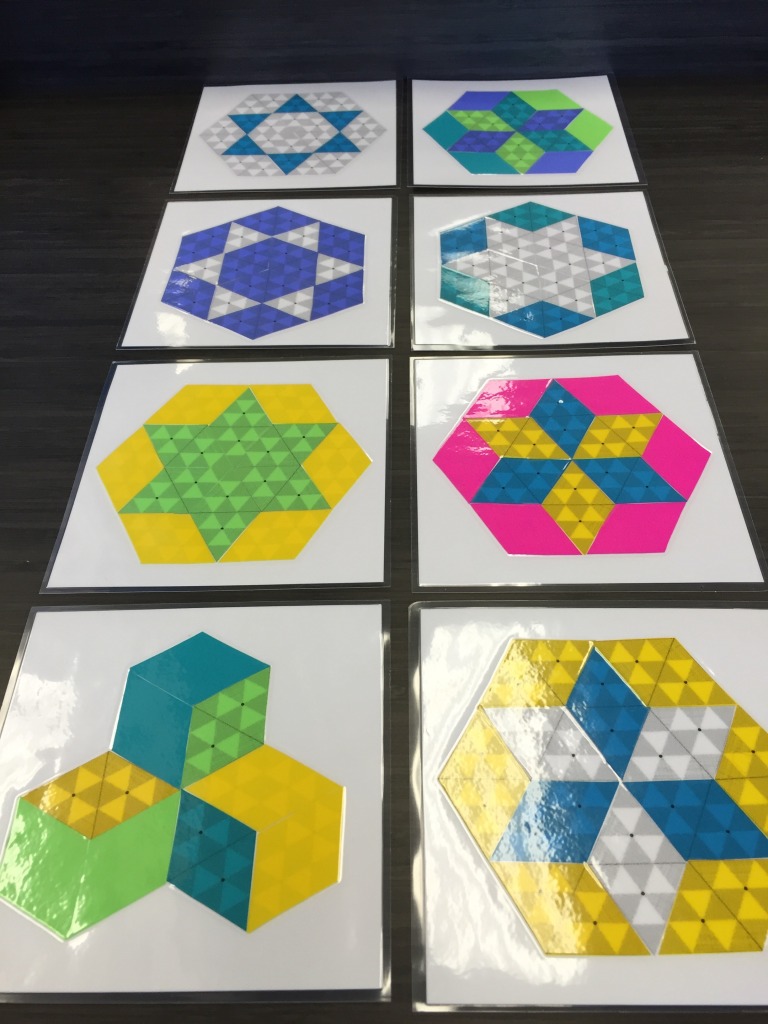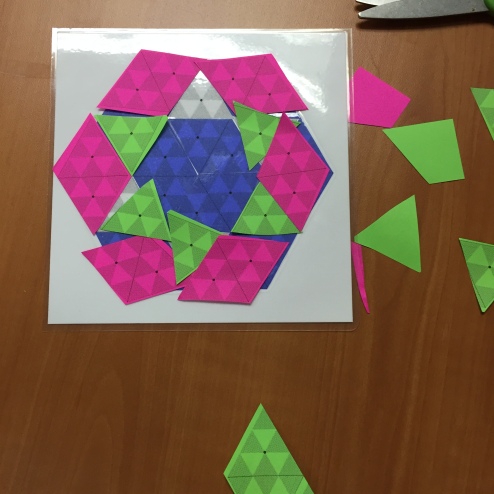It was this piece that made me notice something very interesting about first grade thinking related to shape and structure.

When I asked the creator of the piece above, a first grade boy, about his work we started noticing together. I said at one point, “You know what I notice? I see two triangles on one end, then three triangles, then two, then three more. It looks like you made a rectangle.” His teacher was chatting with him as well and the room was noisy so I missed the conversation that led to the insight, but it was a lovely phrase: “Because of the outside I found an inside.”
The activity was one of four loosely structured math/art stations. In this case there was a visual provocation, a sense of where we might be headed with the materials. At the same time I do make a point to structure and present the materials in a way that leaves them open to possibility and new ideas.

The provocations themselves are all variations on hexagon stars, a project initiated by my friend Paula Krieg. At it’s core is the question: what can you build with rhombi and triangles? The materials are modest — lovely strips of rhombi [PDF], designed by Paula to be printed out on colored paper and cut out and used to create stars and hexagons.
The first thing kids started doing when they arrived at the hexagon station was start cutting.

Over the course of the day I noticed that the kids employed one of three strategies while building their designs.
- Ignore the provocation and just explore.
- Pattern match by overlaying their own cut shapes on top of a provocation piece and then gluing down their design.

- But, by far, the preferred method out of all 150 kids over the course of the day was to look at a provocation design and try to copy it. And, just like the boy at the top of this post, when they copied the shape they BUILT FROM THE OUTSIDE IN. I don’t know about you, but my adult brain wants to build from the center out. I checked in with the classroom teachers and they agreed that would be their strategy as well.Over the course of the day I saw 150 kids so I wasn’t able to capture every example of building outside-to-inside, but here are some representative examples of this phenomenon.
There were kids who saw the structure of how to make a smaller inside hexagon..
…but I don’t think I saw any hexagon made with six rhombi around a center point.
There were also many kids who cut out the rhombuses and then cut the rhombus into triangles. This girl, like many other first graders, painstakingly recreated the star (the inside of the hexagon design) using individual pink triangles. She was working on it for a LONG time.

I think this trend to use the smallest unit (triangles) is somehow related to the inclination to build outside-to-inside. I think it might have to do with unitizing. At the very least there’s got to be a developmental aspect to both of them. I’m not sure what to make of any of this I would so LOVE to hear your thoughts about these observations.
Evening edit: I posted this to Twitter in hopes of gaining some perspective and if turns out math education researchers have observed the out to in progression multiple times. My generous academic source, David Hallowell, says that it “seems to be developmentally normal in concatenation activities. Important for the development of composition and decomposition.” So, essentially, I (Re) discovered something that can tell us where kids are in their mathematical development.
David also pointed me toward this video from Douglas H. Clements whose Learning Trajectories for Young Children has been extremely helpful in understanding the kinds of math children can do. The video is not about “outside to inside” per se, but it’s a quick five minute overview of the progression of how kids learn to compose shapes.
















Wow. Love the video and how it relates to the activity that you brought to the students. IT’s giving me more ideas, inspiration and reasons to work with shapes with young children!
I had been thinking about your outside to inside question. Here’s a theory..perhaps.babies, toddlers, young children are more wired to focus outside of themselves. This occurred to me when I saw the fence that Sonya Post’s student made. Perhaps this greater awareness continually looking outside of themselves is reflected in the way that they make constructions, whereas, as adults, we tend to have a more internal focus, and perhaps that too is reflected in the way we build, from the inside out. Of course I’m not sure of any of this but it’s something that I will be watching for in the future.
I really like working with young kids, but just don’t have many ideas about what to do with them. Your post here is helping me put ideas and justifications together. Thank you!
I just read a post that I think you might like, that put more ideas in my head about working with shapes with children. You might like to take a look at this too https://established1962.wordpress.com/2016/04/21/stars-v-some-work-with-children/
LikeLike